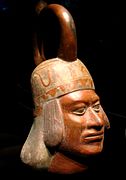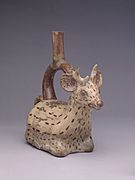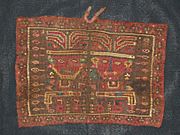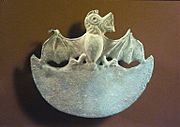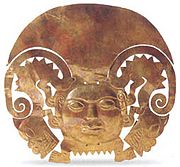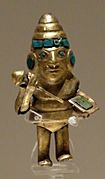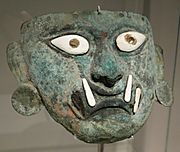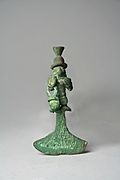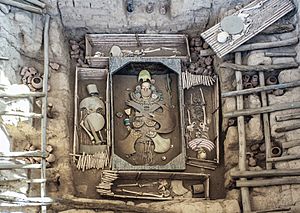Moche culture facts for kids
Quick facts for kids
Moche culture
Moche
|
|||||||||
|---|---|---|---|---|---|---|---|---|---|
| 100–700 | |||||||||

A map of Moche cultural influence
|
|||||||||
| Status | Culturally united independent polities | ||||||||
| Capital | Moche | ||||||||
| Common languages | Mochica | ||||||||
| Religion | Polytheist | ||||||||
| Historical era | Early Intermediate | ||||||||
|
• Established
|
100 | ||||||||
|
• Disestablished
|
700 | ||||||||
|
|||||||||
| Today part of | Peru | ||||||||
The Moche civilization was an ancient culture that thrived in northern Peru. It existed from about 100 AD to 700 AD. Their main city was near where Moche, Trujillo is today.
Many experts believe the Moche were not one big empire. Instead, they were likely many independent groups. These groups shared a similar culture. You can see this in their amazing art and large buildings that still exist.
Contents
What Was Moche Society Like?
The Moche people were mostly farmers. They built clever irrigation systems. These canals moved river water to their crops. This helped them grow food in the desert.
Their art shows us what their lives were like. It includes scenes of hunting, fishing, and ceremonies. The Moche are famous for their painted pots, gold items, and huge buildings called huacas.
Moche history can be split into three main times:
- Early Moche (100–300 AD): The culture began to grow.
- Middle Moche (300–600 AD): The culture expanded and became very strong.
- Late Moche (500–750 AD): Cities grew, and then the culture started to decline.
The Salinar culture was on the north coast of Peru before the Moche. Some think it was a short link between the Cupisnique and Moche cultures. The Moche and Cupisnique shared similar art styles. This includes the 'Spider god' image.
Where Did the Moche Live?
The Moche culture was located along the northern coast of Peru. It covered several valleys like La Libertad and Lambayeque. This area stretched about 250 miles along the coast. It also went up to 50 miles inland.
The Huaca del Sol (Temple of the Sun) was a giant adobe pyramid. It was the biggest building in Peru before Europeans arrived. Spanish explorers partly destroyed it in the 1500s. They were looking for gold.
The nearby Huaca de la Luna (Temple of the Moon) is better preserved. Its inside walls still have colorful paintings and detailed art. Archaeologists have been studying this site since the early 1990s.
Other important Moche sites include Sipan, Dos Cabezas, and El Brujo. Many of their adobe huacas have been damaged over time. But the ones that remain show how bright their murals once were.
Northern and Southern Moche Regions
Experts have found two different Moche areas: Southern Moche and Northern Moche. Each area was likely a separate political group.
The Southern Moche region was probably the main part of the culture. It included the Chicama and Moche valleys. The Huaca del Sol-Huaca de la Luna site was likely its capital.
The Northern Moche region had three main river valleys:
- The upper Piura Valley.
- The lower Lambayeque Valley system.
- The lower Jequetepeque Valley system.
It seems these Moche centers developed somewhat on their own. They likely had their own rulers. Sometimes, one group might have controlled the whole Moche area, but this was not common.
Pampa Grande, in the Lambayeque Valley, became one of the largest Moche sites. It was important from 600–700 AD. It has a huge ceremonial area. This includes Huaca Fortaleza, the tallest ceremonial platform in Peru.
San Jose de Moro is another northern site. Many Moche tombs have been found here. Some tombs belonged to high-ranking women. These women were shown in Moche art as 'the Priestess'.
Moche Art and Craftsmanship
Amazing Moche Pottery
Moche pottery is known for being very diverse. They used molds to make many pieces. This helped them produce certain shapes quickly. Moche ceramics show many parts of their daily life. This includes war, metalwork, and weaving.
Their pottery often used red and white colors. They painted fine lines and made realistic figures. Moche pots have been found at major sites and small villages.
Because irrigation was so important, Moche art often showed the movement of liquids. Especially life fluids through the body.
Moche pottery colors were often simple. Yellowish cream and rich red were used on important pieces. White and black were rare. The Moche are famous for their portrait pottery. These pots seem to show real people. Many portraits show people with unique physical features.
The realistic details in Moche ceramics might have been for teaching. Older generations could use them to teach younger ones about their culture. The pottery could show about life, social rules, and how life and nature are connected.
Moche Textiles
Not many Moche textiles have survived because of weather and time. But some pieces have been found in tombs. These often belonged to important people. From these, experts learn about Moche culture.
The Moche wove textiles using cotton and wool from vicuña and alpaca. The types of fabrics and patterns changed over time. Early Moche textiles are rare. Around 450 AD, men's head cloths were common.
It is thought that skilled artists made textiles for the Moche elite. Regular people likely made their own clothes. Tools for spinning and weaving are often found in Moche homes. This suggests home production. However, later textiles might show more mass production.
Fancy weaving and bright dyes were common on clothes for the rich. Commoners likely had simpler clothes with less dye. Complex tapestries were also a sign of high status. Some clothes were specific to gender. For example, men wore head cloths, and women wore long tunics. Today, descendants of the Moche still have strong weaving traditions.
Amazing Metalwork
The Moche were very skilled metalworkers. They discovered ways to cover copper with thin layers of gold or silver. This was done using special chemical processes.
For a long time, Moche pottery got the most attention. But now, experts are seeing how important metalwork was. The skill needed to create these metal objects was truly amazing.
The first Moche metal items were found in the late 1800s. But they gained more attention in the 1940s. This was after a Peruvian researcher, Rafael Larco Hoyle, wrote about them. He described large headdresses and nose ornaments. These were often found with Moche leaders.
A very important discovery was the Tombs of Sipan in 1986. These tombs had many metal objects. They showed that metal items were a big part of the Moche elite's power. Moche rulers used art, including metalwork, to show their power.
Moche metalworking techniques were very advanced for their time. Modern metalworkers find it hard to recreate them. The Moche likely used long tubes to blow air onto coals to heat metal. This was different from European methods. Bowls from the Moche culture even show this process.
Many Moche metal techniques were their own inventions. But some came from the earlier Chavín culture. Like the Chavin, they used alloys of gold, silver, and copper. Moche art also continued to show human-like figures and characters with fangs.
Many Moche techniques, like electroplating, were used for thousands of years. They continued until the Inca conquered the area.
Molds used to shape metal sculptures have been found. They were made of metal or wood. Researchers found that the thickness of the metal sheet was very important. If it was too thick, it wouldn't capture details. If too thin, it would tear.
After shaping, other pieces could be added. This was often done by crimping or interlocking parts. Soldering was also used. Finishing touches included embossing and adding precious materials. Stones like lapis lazuli, turquoise, and shells were embedded in Moche metalwork.
Some of these materials were not found on the Moche coast. Lapis Lazuli came from Chile, hundreds of miles away. Spondylus shells came from Ecuador. This shows that the Moche had wide trade networks. They likely had contact with other cultures. Also, many animals shown in their art are from the Amazon rainforest. This further suggests distant connections.
Gallery of Moche Art
-
Resting deer,
Larco Museum Collection, Lima -
Moche warrior pot, British Museum, London
-
Crescent-shaped ornament with bat, CE 1–300 Brooklyn Museum, Brooklyn
-
Copper alloy mask with shell, CE 1–600 Walters Art Museum, Baltimore
-
Copper knife with removable figural handle, 50–800 AD Walters Art Museum, Baltimore
-
Bronze and shell Moche mask depicting the hero Ai Apaec
-
Copper ceremonial knife (Tumi), 3rd – 7th century AD, Metropolitan Museum of Art, New York City
Moche Religion and Beliefs
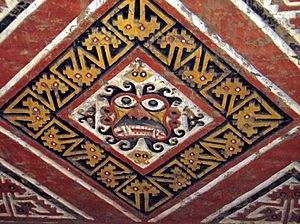
Moche art and human remains show that rituals were an important part of their religion. These rituals often involved important leaders. Some experts think the people in these rituals were warriors captured in battles. Others believe they were local leaders who lost ritual fights.
Archaeologists have found groups of people buried together near Moche huacas. They also found skeletons of young men whose flesh was removed. This might have been for display in temples.
These rituals may have been linked to renewing ancestors and making crops grow well. Moche art shows a figure called the "Decapitator." It is often shown as a spider, a winged creature, or a sea monster. These three forms represent land, water, and air. It is also shown as a human figure with a tiger's mouth and fangs. The "Decapitator" was likely a very important figure in their beliefs about these rituals.
How Moche Society Was Organized
Experts are sure that Moche society was divided into different groups. There was a general upper class and a lower class. Each of these could be split into smaller groups. People could move within their class. But it was harder to move between the upper and lower classes.
Religion helped unite the Moche people. But the elite class likely used it to keep their power. They might have used ceremonies to show their high status. Physical force might have been used too. Some think that arguments among the elite might have led to the culture's collapse.
Moche burial sites give us a lot of information about their social structure. People with lower status were buried in simple holes near their homes. High-ranking people were buried in platform mounds with many valuable items. These items included copper masks, silver, pottery, and gold. Metal objects were especially important for showing high status.
Excavations also show that living conditions differed by social standing. However, more research is needed here. Elite burials show that both men and women held important positions in Moche society.
Why Did the Moche Civilization Decline?
There are several ideas about why the Moche political system ended. Some experts believe climate change played a big role. Studies of ice from Andes glaciers show major climate events between 563 and 594 AD. This might have been a super El Niño. It caused 30 years of heavy rain and floods. This was followed by 30 years of drought.
These weather events could have greatly disrupted Moche life. They might have challenged their leaders and their faith. The severe drought would have hurt their farming. Moche farming relied heavily on irrigation from mountain runoff.
However, other evidence shows that these events did not completely destroy the Moche. Moche groups survived past 650 AD in some valleys. For example, in the Jequetepeque Valley, later settlements had forts. This suggests social unrest, possibly due to climate changes. Different groups might have fought for control over scarce resources. There is no strong evidence of an invasion by another culture like the Huari.
Moche Connections with Other Cultures
The Moche culture existed during the Early Intermediate Period. It came after the Chavín horizon and Cupisnique cultures. It was followed by the Huari and Chimú cultures.
The Moche also lived at the same time as the Ica-Nazca culture in the south. They likely had some contact. They might have traded for guano (bird droppings) for fertilizer. Moche pottery has been found near Ica. But Ica-Nazca pottery has not been found in Moche areas.
The Moche also co-existed with the Recuay culture in the highlands. Some Moche art designs can be traced back to Recuay art.
The Moche also interacted with the nearby Virú culture. Eventually, by 700 AD, the Moche took control of the Viru.
Important Discoveries About the Moche
In 1899 and 1900, Max Uhle was the first archaeologist to dig at a Moche site. This was Huaca de la Luna. The name of the Moche culture comes from this area.
In the late 1930s, Rafael Larco Hoyle made the first big interpretations of Moche culture. He said the Moche were a "highly advanced society." He pointed to their "exquisite artworks" and "large public works."
A very important project was the Virú Valley Project in 1946. It showed an earlier pottery style called Gallinazo. This style seemed to end suddenly.
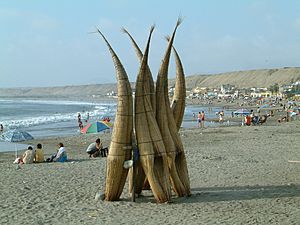
In 1987, archaeologists found the first untouched Moche tomb at Sipán. This was in northern Peru. Inside, they found the preserved remains of a high-ranking man, the Lord of Sipán. He lived around 300 AD. The tomb also had six other people, animals, and many valuable items made of gold, silver, and other materials. Since then, thirteen more tombs have been found at the site.
In 2005, a preserved Moche woman, the Lady of Cao, was discovered. This was at the Huaca Cao Viejo site. Her tomb was very elaborate and had not been disturbed since about 450 AD. It contained military items like war clubs. The remains of a teenage girl, likely a servant, were also found.
In 2005, a gold mask was found in London. It showed a sea god. Experts thought it was stolen from a Moche tomb in the late 1980s. It was returned to Peru in 2006.
In 2013, archaeologists found the eighth female skeleton in a series of discoveries. These finds, starting with the Lady of Cao, suggest that Moche society was ruled by priestess-queens. According to the project director, Luis Jaime Castillo, "this find makes it clear that women didn't just run rituals... but governed here and were queens of Mochica society." No entombed men have been found in these specific types of burials. This discovery was made at San José de Moro in the Jequetepeque Valley.
See also
 In Spanish: Cultura moche para niños
In Spanish: Cultura moche para niños



